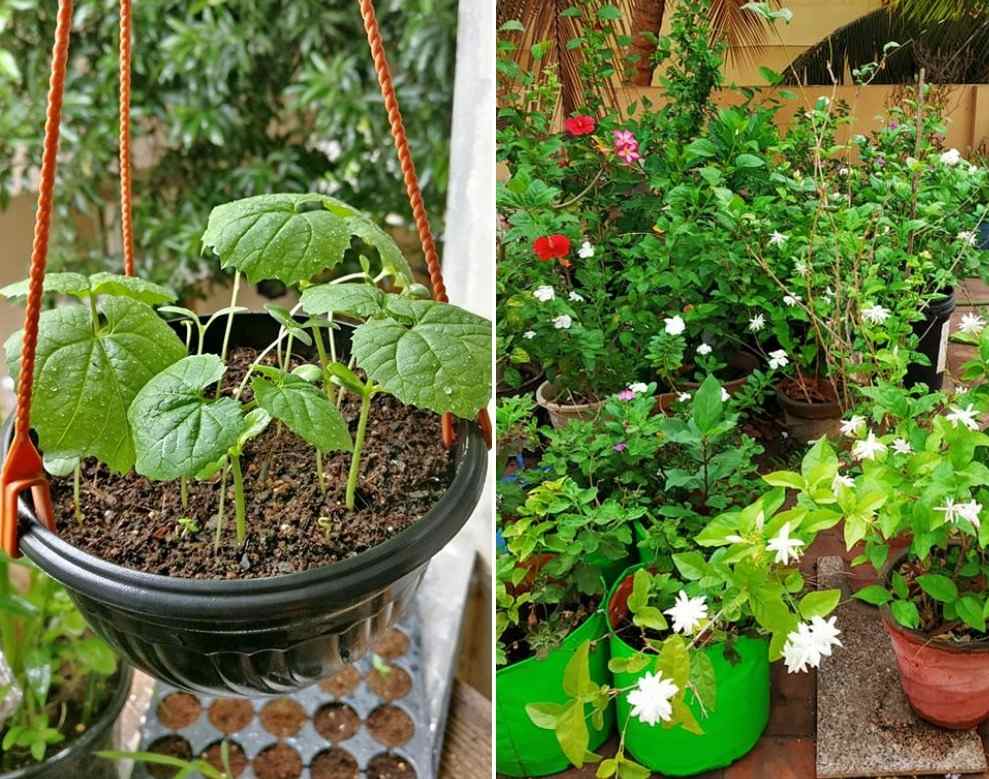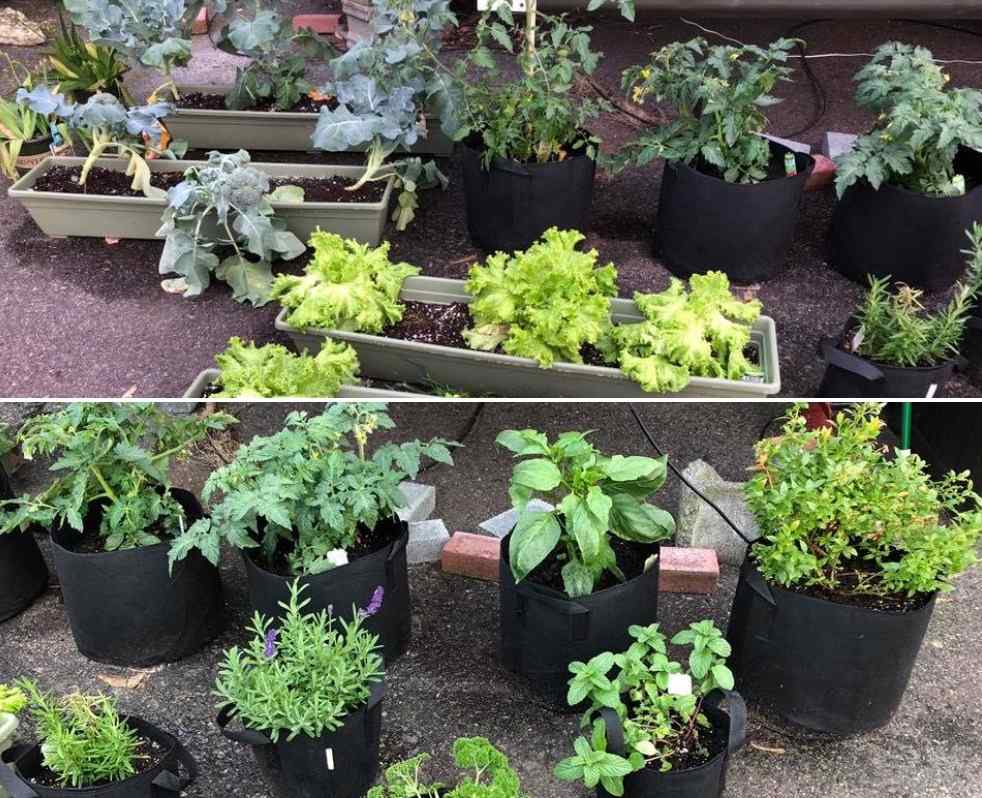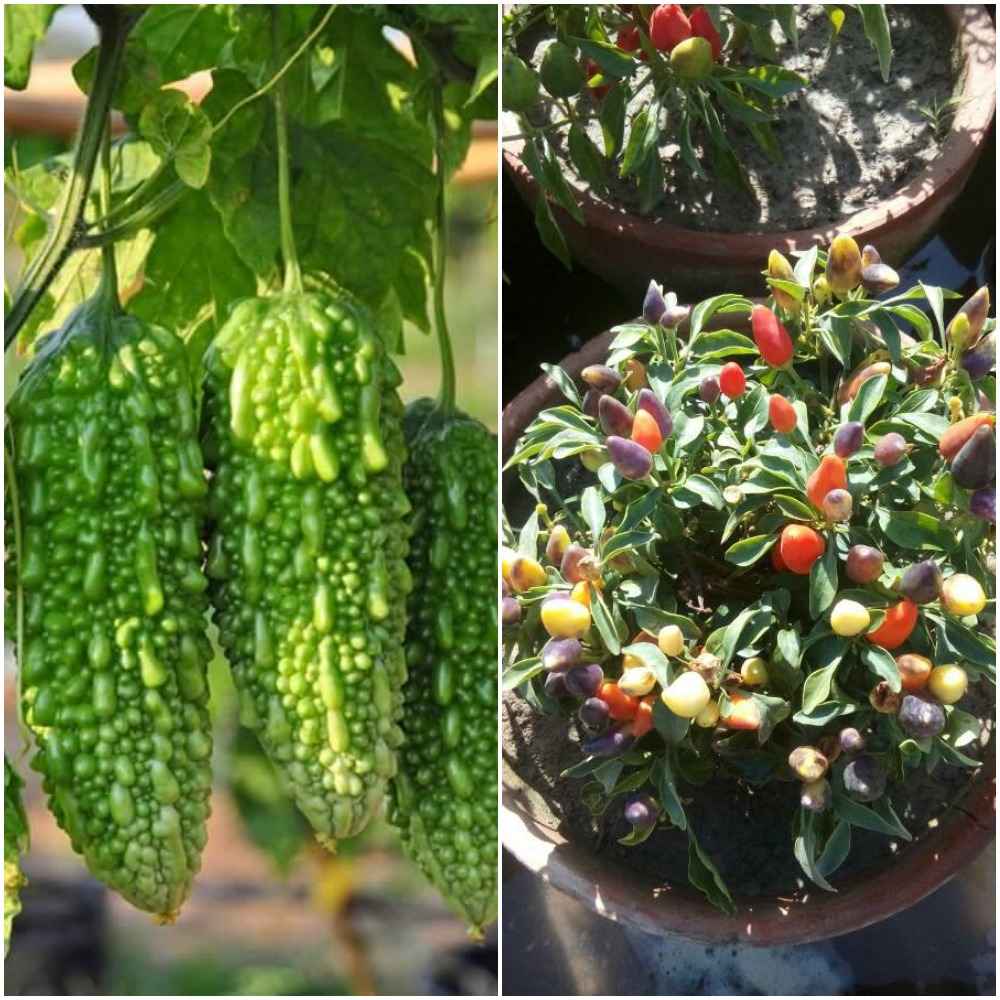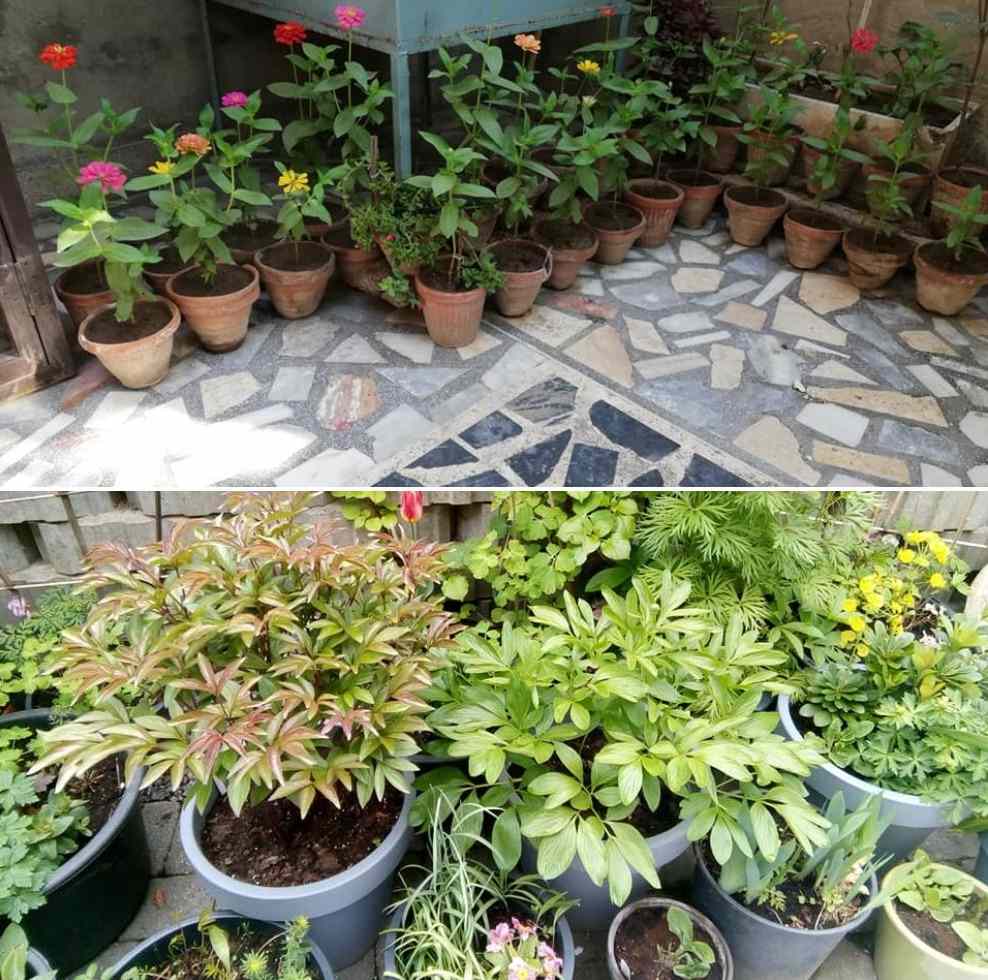Introduction: Hello gardeners today we are back with great information on apartment container gardening. Container gardening or pot gardening in apartments are ideal for those with little or no garden space. With container gardening, you can obtain creativity with your space using hanging planters and shelves as well as available ground space. Additionally, plants such as herbs and succulents can take up minimal room, and can even be grown on a windowsill.
A step-by-step guide to apartment container gardening
You can also grow pretty and useful plants if you opt for a container garden. There are a few rules you will have to follow when starting an apartment container garden. There are mainly five elements that are crucial to your apartment container garden the pot (size for each plant), the soil, how much light your plants will require, watering requirements, and fertilizer. For example, herbs do not require big pots but they do need at least 6 hours of sunlight. Their fertilizing is minimal and they require good drainage in loose soil. Container plants come in a different variety of shapes, sizes, and colors.

Tips for starting apartment container gardening
Here are a few tips that will help you to start apartment container gardening;
- Most container plants like to get at least 6 hours of sunlight per day. Check the label when you buy, or ask for advice from the garden center for suggestions based on how much light you get.
- Some of the best plants for container gardening in a small apartment space are chard, lettuce, cherry and bush tomatoes, peppers, eggplants, green onions, Asian greens, and herbs.
- Not every plant wants a separate container. Try pairing a climbing plant with a plant that’s lower to the ground, or make an herb garden by planting a variety of herbs in one large pot.
- Be sure to water your container plants regularly. Additionally, plant food can be helpful for container garden plants.
Choosing the right container
Choosing the right container is important for you and your plants. You will want to select a pot that is complementary to your home or outside patio and you also want to meet the needs of the plants. Cedar containers and redwood containers are rot-resistant while other woods will rot. If you do want to use wood pots make sure that they are not treated with harmful chemicals that will be detrimental to your plants. Do not use plastic pots in the sun; they will fall apart quickly. Terra Cotta containers do not do well in the sunlight and they dry out quickly and have a tendency to crack and break. The best pots to use for your container garden in the apartment are glazed ceramic pots. These are pretty and colorful however make sure there are plenty of drainage holes.
Plastic pots are the least expensive container option, so they are great for anyone on a budget. Indeed, they are generally the least attractive option, but they hold their moisture longer than clay or ceramic pots and are lighter and easier to move around.
You should not miss the Best Fertilizers for Plants.

Clay pots are porous, so air moves simply through their walls. This is helpful in that it allows roots to breathe and keeps them out of direct water, but it’s not helpful in that the soil tends to dry out very quickly. In hot weather, you’ll want to closely monitor the moisture in your clay pots. They are a fairly inexpensive choice for the home gardener after plastic, and they come in a myriad of shapes and sizes. If you select clay pots, be sure to purchase a saucer or plate to sit under the pot.
Container size for apartment container gardening
Pots come in a different variety of sizes. The width of the opening at the top determines the container size. A 4-inch pot has an opening 4 inches wide and most pots are as deep as they are wide. Azalea pots, however, are three-fourths as deep as they are wide; bulb pots are half as deep. Growers have found that some plants look and produce better in shallow pots.

Keep containers clean to prevent disease. If you plan to reuse a container, clean it well both inside and out. Clay pots often get a white crust on them after prolonged use and to remove this crust, scrub with a steel-wool pad or stiff brush in a vinegar and water solution. If the crust is thick, brush first with a dry steel wool pad and rinse pots then soak them in a bleach solution (1 part bleach to 9 parts water) for 30 minutes.
Soil for apartment container garden plants
By using potting soil in your containers and soil mixes are formulated to maintain a certain level of lightness so that container plants can breathe, drain well, and still hold in some moisture.
Container plants depend on the soil they are planted in for water, air, and nutrients. Since your apartment container garden will probably mean growing in containers, you cannot use ordinary garden soil. It will compact into containers, preventing water from flowing through and there will be no space for air. A good well-draining potting mix is necessary and the potting mix has several advantages. Some of the advantages of potting mix are;
- It is lighter and weight is an issue when you are gardening above the ground.
- It will be somewhat sterile, so you will not have to worry about plant diseases getting a free ride.
- And it remains fluffy so there will be air pockets for the roots to access and water can flow freely.
You may also like the How to Create a Miniature Garden.

Don’t Disregard the Soil
Soil type is very important for plant health and growth. Many container plants prefer a higher acidic to neutral soil with a 7.0 pH level or above. Fertilizer can be used in potted plants but must be mixed with regular potting soil to avoid over-fertilization. Make sure all planters have enough drainage provided by holes in the container bottom. A single layer of rocks can be added carefully to the bottom of the planter to avoid blockage of drainage due to compacted soil.
Choose a place with adequate sunlight
Most container plants need a full day of sunshine. Before you buy any plant, take the time to learn how many hours of sun per day your apartment receives. Pay attention to indirect light as well and no trees or walls blocking large portions of the sky. Even a north-facing balcony in apartments can be a happy home for several plants if there is enough indirect light.
Choose plants for apartment container gardening
Lettuce and herbs do well in relatively shallow containers with very large surface areas. Select containers that allow about four inches of soil. If you plant two pots, you can snip what you want off one container and then harvest the second while the first recovers. And keep the soil moist.

For example, tomatoes need deeper pots. Many people will use deep buckets filled with a mix of potting soil and compost. Unlike lettuce, which wants continuously moist soil, let tomato containers dry between watering.
Water requirement for container garden plants
Plants in containers require a lot of water, often several times a day. You want to be sure you choose a spot for your container garden that has access to a water supply. Carrying watering cans up and down stairs can obtain tedious quickly.
Watering a container garden must be your utmost concern. It will take time to find out the right schedule for the individual plants since they all have different needs. If you are having an extremely hot spell it will be essential to water every day.
Fertilizing
Fertilizing is an important aspect of container gardening. When a plant is in a container it only has a small amount of soil to draw nutrients from so you will have to provide it a little help. To be consistent it is advised to fertilize plants on every other watering. Don’t just use one fertilizer; a mix of nutrients will keep your container plants happy and healthy.
You may also consider reading the Potting Soil Mix for Vegetables.
Feeding your plants
Unless you bought a potting mix that contains fertilizer, you will want to feed your plants on a regular schedule. A water-soluble fertilizer that can be added when you water is generally easiest. Plan on plant-feeding them every other week or whatever is recommended on the fertilizer label.
Pests and diseases in container garden plants
Pests and diseases have a way of finding plants no matter where you produce them and there are no natural predators for insects indoors. Monitor your container plants whenever you water them or harvest. Catch problems as early as possible. If you see a problem, move that plant away from the other container plants until the problem is remedied.
List of plants for apartment container gardening
Some of the plants suitable for apartment container gardening can be given below;
Herbs and Mints
Herb plants are probably the easiest edible plants to get started with. They flourish in smaller containers and can be grown year-round on windowsill using indirect lighting.
Snake Plant
Snake plants are some of the most tolerant plants out there and they can withstand weeks of neglect without losing their shape and fresh look. Snake plants are great for the novice green thumb as they can thrive in environments with low light and water. Added benefits contain their ability to help purify the air by removing toxins like formaldehyde and benzene.
Pothos
This leafy green plant is ideal for adding lively accents higher up in your apartment. These plants are perfect for hanging baskets or climbing plants. Plus their purifying qualities allow them to absorb and strip toxins like formaldehyde often found in common household items such as carpets and area rugs.
Salad greens
Salad favorites such as lettuce, spinach, and arugula are quick-growing, shallow-rooted plants in apartments. They can develop in less than ideal conditions, providing they obtain plenty of water.
Begonia
There is a wide range of begonia plants on the market these days. Some have gorgeous flowers in several varieties of colors. They are perfect in pots, indoors, flower beds, containers, and hanging baskets. This plant needs little care and attention. Water it generously, but allow the soil to dry and add fertilizer to the soil once a month.
A simple pot of begonia plants can be planted for next to nothing and yield a nice season of color. Better yet, there are untold varieties of begonia plants, including the trailing or bushy varieties, and all manner of foliage begonias. All types of begonia plants make excellent container garden plants. They need slightly moist, well-drained soil, and grow best in part sun.
In case you miss this: Air Purifying Plants for Home.
Peace Lily
Peace Lily plant is a popular indoor plant. These indoor plants require little to no sunlight. They grow well in shades and need little watering. Peace lily plants’ beautiful white bracts and tiny flowers flourish in low lighting conditions and it removes the toxins from the air, which is an added benefit.
The peace lily is so low-maintenance that it is a great houseplant for the houseplant challenged or as a housewarming gift. It does not require much direct light and can handle an occasional over or under-watering.
Lucky bamboo
Lucky bamboo only needs water and shade to survive, and in addition to its good looks, bamboo is also meant to create a positive living environment. The lucky bamboo plant is not a real bamboo but a member of the lily family. This low-maintenance tropical plant is known to bring good luck and fortune. While it can become 2 to 3 feet tall over time, you can maintain its size by cutting the top off with a shear to the desired height. You can grow this bamboo plant either in the water or the soil, keeping it in a location that is bright and receives filtered sunlight.
Spider plant
Spider plants are most commonly grown as houseplants; they create excellent container plants for shade. The spiky foliage can be bright green or variegated, which makes a lovely contrast against another type of plant.
This small indoor spider plant can thrive in the neglect. The spider plants know how to survive in tough indoor conditions; they too choose exposure to bright indirect light and a few hours of filtered sunlight. And keep the temperature around them warm and water regularly.
Hibiscus
This tropical shrub has big, beautiful flowers that come in a wide range of colors. Hibiscus is a large container plant that will need frequent watering so the soil doesn’t dry out. Place these lovely potted plants in full sun, and they will happily bloom all year round.
Flowering Kalanchoe
The Flowering Kalanchoe plant can impact your indoor decorations positively. This striking succulent plant is no match when in bloom and doesn’t grow above 6 to 12 inches tall. Kalanchoe plant prefers warm temperatures and a well-lit place to sit. Keeping it near a south or west-facing window is useful if you want to encourage more blooms.
Succulents
Succulents are great container plants that produce in small pots, or they can be combined into larger arrangements. They are easy-care indoor potted plants for full sun, but some types will tolerate part-shade. Just be sure their soil drains quickly, and let it dry completely between watering.
You may be interested in Crops Suitable for Drip Irrigation.
Conclusion
If you live in the following cities/states of India and plan to set up a container garden in your apartment, this article may help you to grow plants in containers of apartment.
| Mumbai/Bombay | Kolkata | Bengaluru | Jaipur |
| Chennai/Madras | Hyderabad | Secunderabad | Pune |
| Ahmedabad | Surat | Agra | Lucknow |
| Varanasi | Kochi | New Delhi | Chandigarh |
| Bhopal | Visakhapatnam | Nagpur | Madurai |
| Indore | Amritsar | Kanpur | Patna |
| Nashik | Vadodara | Thiruvananthapuram | Dehradun |
| Vijayawada/Guntur | Warangal | Karimnagar | Coimbatore |
| Raipur | Udaipur | Meerut | Ludhiana |
| Jamshedpur | Jabalpur | Guwahati | Gwalior |
| Dhanbad | Faridabad | Rajkot | Srinagar |
| Mangaluru | Aurangabad | Kota | Solapur |
| Asansol | Gandhinagar | Tiruchirappalli | Salem |
| Tirunelveli | Vellore | Tiruppur | Uttara Kannada |
| Chitradurga | Thane | Cuttack | Kannur |
| Jodhpur | Ranchi | Mysore/Mysure | Bhubaneswar |
| Andhra Pradesh | Karnataka | Haryana | Sikkim |
| Arunachal Pradesh | Kerala | Himachal Pradesh | Tamil Nadu |
| Assam | Madhya Pradesh | Jharkhand | Telangana |
| Bihar | Maharashtra | Nagaland | Tripura |
| Chhattisgarh | Manipur | Odisha | Uttar Pradesh |
| Goa | Meghalaya | Punjab | Uttarakhand |
| Gujarat | Mizoram | Rajasthan | West Bengal |